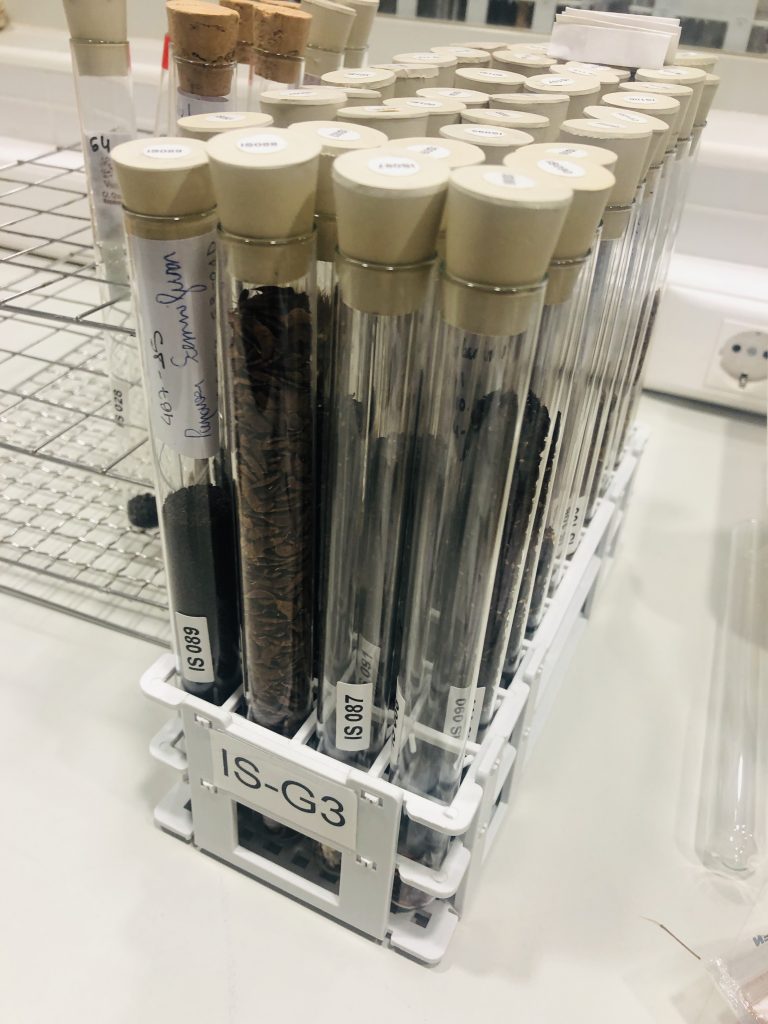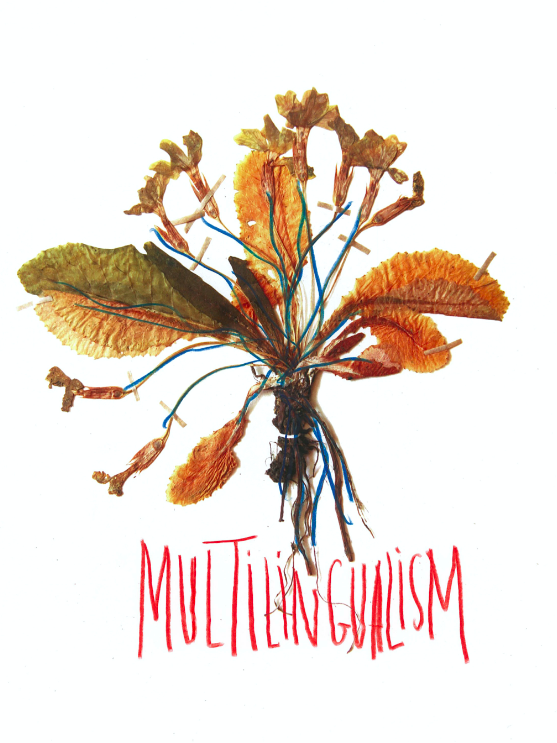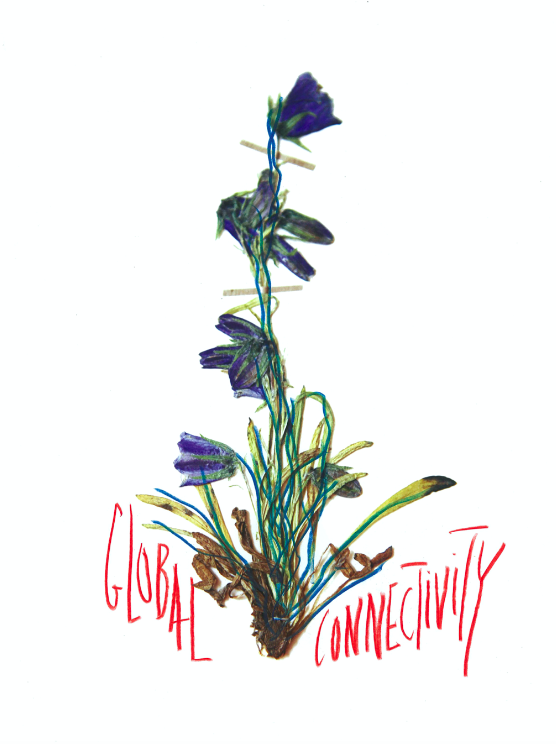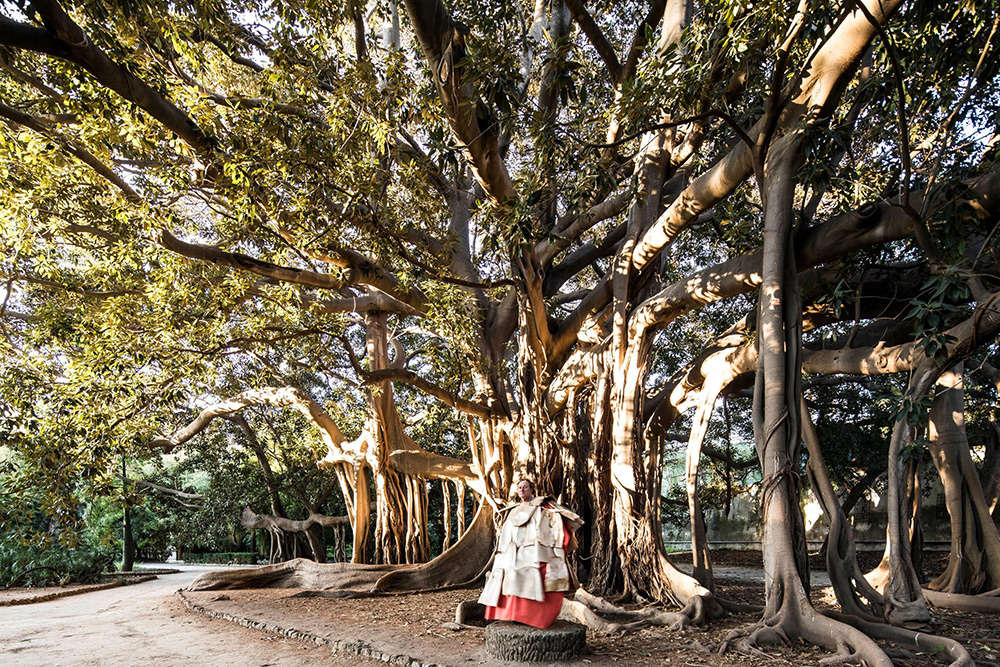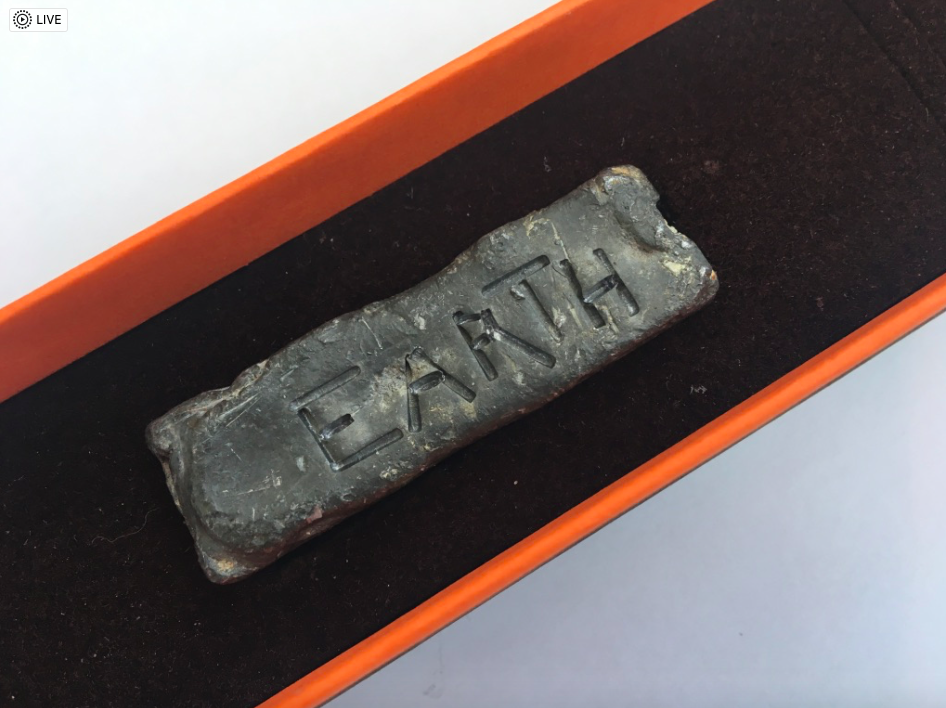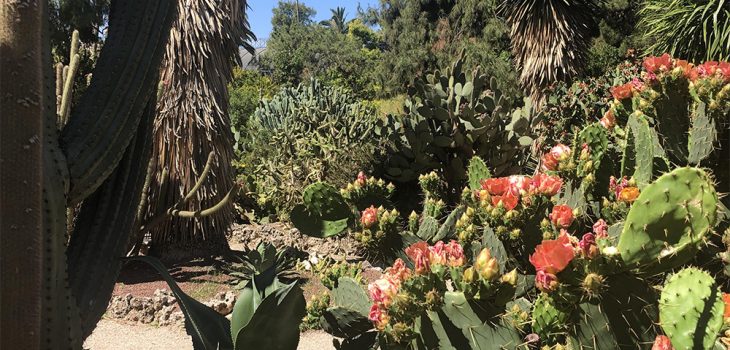
Art and Ecosystem: Interaction for the New World
Perspectives on Biodiversity. Interview with Yann Toma (Contemporary Artist) and Olga Mayoral (Scientist, Valencian Botanical Garden).
Article by Maritima01
Regarding the theme of the Mediterranean environment and biodiversity, let’s not forget about the flora, the plants!
Did you see during the last Manifesta, the artistic installation and the work of the artists exhibited in the decor of the botanical garden? It was one of the best parts of the whole program.
In an instant, you leave civilization to find yourself in the middle of nature, the time of a stroll in a true haven of peace and relaxation where the beauty of the natural world crosses calm and fullness, to meet artistic thoughts and images exposed all along your route.
Many botanical gardens are created all over the world, what is their role and what are they studying exactly?
In order to better understand their role, and also their desire to interact with contemporary artists, we interviewed the scientific team from the laboratory of the Valence Botanical Garden, where an exhibition of the Maritima project is planned.
1. What is biodiversity?
Biodiversity includes all things living together with their characteristics, including the cultural traits that characterize the living populations on Earth.
The Biodiversity we know is the result of a million years of evolution.
The concept of Interdependence means that the loss of Biodiversity is generally achieved at the expense of the remaining Biodiversity.
2. Why do we need to preserve Biodiversity?
Human well-being (ecological, economic and cultural) requires the preservation of Biodiversity. We depend on a large number of animal and plant species used in many products (food, health …). Biodiversity plays an important role in the culture and identity of the different regions of the globe.
3. Botanical Garden of Valencia, what is it and what exactly does it do to preserve biodiversity?
Over the past three centuries, the acceleration of agricultural expansion techniques as well as the industrial revolution and urbanization have led to the reduction of Biodiversity.
Climate change could lead to the loss of more than half of the plants in some European ecosystems. It is becoming more and more important to protect and preserve Biodiversity.
Having a seed bank in our laboratory, we study them and also work on the conservation of species with 2 main methods:
- The In-situ method which preserves genes, species and ecosystems in their natural environment through legislation.
- The Ex-situ method which conserves Biodiversity outside areas where populations appear naturally (botanical gardens, zoos or seed banks).
Would you be interested in establishing a dialogue with other contemporary artists? Why?
Olga Mayoral, Scientist,
Valencian Botanical Garden
Coming from a scientific academic background I find interesting the relationships that I could establish with artists as a way of enriching our point of view. Art offers us a magnificent opportunity to provide humanity to our work and serves as a bridge with a large part of the citizenship that is more distant from the scientific field.
From a personal point of view, coming from a family of artists, am especially looking forward to re-establishing links with contemporary artists.
What do you think about the quarantine measures introduced, will it really affect the state of the environment or is it impossible with such a short time?
Olga Mayoral, Scientist,
Valencian Botanical Garden
We already know that the environment is being benefited in terms of air pollution and in some other aspects. Of course, if these quarantines don´t last long (as we all hope), these improvements will be temporary but will teach us that it is possible to reduce pollution if we really want to. On the other hand, we are experiencing an enormous increase in the use of plastic and packaging, masks, rubber gloves, etc., which is perfectly logical but will need especial management.
Once more, I think that this terrible actual situation is showing how biodiversity loss is hurting our ability to combat pandemics. We had been repeatedly warned by scientist that the increasing frequency of disease outbreaks is linked to climate change and biodiversity loss but now we are suffering the consequences in a very direct and dramatic way. I am optimistic on the part of the lessons we are learning that I hope will enable us to take more sensible actions from now on.
Conversation between Elena Posokhova (curator, founder Maritima01 project) & Yann Toma – Artist -Observer at the UN and doctor professor at the universities of Paris 1 Panthéon-Sorbonne where he heads the Art & Flux research team (Art, Diplomacy, Innovation). His work is featured in many collections, including the Centre Pompidou, and entered into the prestigious Fonds National d’Art Contemporain (FNAC) collection in 2007.
Yann Toma is a Resident artist at Maritima project. He will explain us his project, created especially for the exhibition at the Valencia Botanical Garden, as well as his many artistic experiences and botanical gardens creation.
E.P. Which is your opinion on the importance of the dialogue between scientists and artists?
Y.T. I am an artist-observer at the UN where I serve as artist in residence since 2007 in this way I am in permanent connection with what shakes or unites the world community.
In the past I have conducted several monumental projects relating as much bodies as some emblematic architectures such as the Grand Palais, and I have been part of the scientific world for many years as a research director, and thanks to those experience it seems to me that the scientific community, like the artistic community, have much to contribute one to the other. We have to define the territories that we could consider carriers for such interaction because this dialogue must be situated on a field of emulation.
Thus, neither art nor science should appear as pretexts for the creation of shapes without loads. In the field of what Artistic Energy could represent for science, we see today that we have the chance to solve the problems of the contemporary world, and this union between the two fields can fully reveal. In both botanical and biological environments, in which I am particularly interested, I try to relate the plant world and the world of humans, in particular by setting up contact zones based on the intelligence of plants and the notion of animal magnetism, an artistic research which would be able to show an invisible matter which combine the world of living. What Wilhem Reich calls orgone energy, a mass-free common energy.
E.P. Why is it necessary?
Y.T. Today there is a need to accelerate the links between the actors of the world. First of all because the methodologies differ and they benefit from being combined and compared. We can thus introduce innovation into working protocols and circulate the link between creation and creativity.
The challenge for the art world, in this context, probably it is to do as much useful work while at the same time retaining its share of mystery and light.
The challenge for science, instead, is to inscribe something sensitive in what often appears to be processual and enclosed in a logic validated by specialists.
We must “phosphorus” and feed ourselves of such meeting.
E.P. Your current project is linked to botanical gardens. Which questions do you have for garden laboratory scientists?
Y.T. Climate change is the major issue of our time and we have to do something about it. Before that it could be too late we need an unprecedented effort from all sectors of society. In this very uncertain world context, it seems to me essential to consider that this “art and science” relationship must prove to be an engine of innovation and renewal.
In my idea it is fundamental that an action for the climate through art should take place in areas where biodiversity is questioned. So the botanical garden is the ideal environment for that.
The first question would be how do the scientists at the Valencia Botanical Garden today consider the artists’ desire to get closer to their scientific activities in the garden?
Currently, the world scientific community as well as many governments and NGO have expressed serious concerns about many changes in this biogeographical field, especially in the Mediterranean Sea. Given that, the scientists at El Botànic are conducting research on plant diversity, the conservation of rare, endemic or threatened species of the Mediterranean flora and the conservation of natural habitats, do these problems now affect the balance of the botanical garden and their own research? Everyone who is responsible for the environment says so, it seems essential to raise public awareness by questioning our relationship with the living and nourishing marine ecosystem of the Mediterranean. We must create sustainable and healthy solutions for our environment and above all we have to try to avoid the tragic disasters that seem to be on the horizon for nature.
Through its educational and cultural activities, the Valencia garden and its garden scientists have extensive experience in dealing with the public.
How do they think the public could contribute to the conservation research by botanic garden scientists? Have they already thought about it and do they have experiences to share in this area? A third question would be to ask ourselves what the plants have to teach us in terms of the organization of our living space and reflection. Has the daily work of scientists in the botanical garden changed their outlook on the world, their lifestyles, their link to the notion of beauty? Can everyday life with plants lead us to change paradigms?
E.P. Which is the message of your project?
Y.T. As ambivalent as un predictable, I ask myself globally and locally about which is the encounter between the concept of Artistic Energy (EA) in connection with the Capitalocene, this new industrial era that has upset all the natural balances of our planet. This posture can be raised today by a deep reflection on our future. The Capitalocene itself embodies the irreversible progression of industries and successive stages of exhaustion which lead us to doubt the world that is waiting for us. “Designating roughly the same phenomenological reality as the Anthropocene, the Capitalocene is a concept that takes as its starting point the idea that capitalism is the main responsible for the current environmental imbalances. (MALM, Fossil Capital: The Rise of Steam Power and the Roots of Global Warming). This concept of Capitalocene (created by the sociologist Jason W. Moore) appears to me and allows me to insist artistically on the ecological consequences of capitalism. But so far I dont have a sense of disappointment for y research. I felt for several years a sense of urgency, leading myself to deepen my reflections on a political ecology driven by art, which led me to recently realize several travels in Italy, Romania or in New York dressed of vegetable coats, I try to relate the lost dreams of Arcadia to our possible becoming vegetal. All the researchs that we are carried out in El Botànic is part of this reflection and can, in my opinion, come into convergence with a production and dissemination of Artistic Energy.
E.P. Which artistic expression do you intend to create?
Y.T. My project, which could be entitled “El Arca de Noé del Botànic” is linked to Mediterranean 2020 and it is part of the reflection on inter generational participative practices as well as on the intelligence of plants. The idea of the project is to transmit the powerful energy of our ecosystem and to embody it living the nature by ourself, while protecting it in the eyes of all.
On the basis of what the young human generation and the vegetal one will transmit to me, I may be able to gather a common intelligence at the heart of the Valencia Botanical Garden. For this, I will act in two stages. The first will be a series of interviews with garden scientists (we will transcript and pubblish these meetings).
The second step will be the invitation to scientists, then to the public to reveal the energy of the Mediterranean through the manufacture of shared plant architectures and coats which will be worn later as a living emblem and a revelation of the difficult question of human management of climate change. This process will be followed by a ritual walk in the heart of the city of Valencia, between El Botànic and the Mediterranean coast. At the same time, I will do a photographic work on the seeds collected by the scientists and will try to discover that its artistic energy could be found in them through the installation of a vegetable fable.
E.P. What project would you like to implement in collaboration with scientists from the University of Valencia at the residence? (thematic, seed bank, herbarium)
Y.T. This residency will take place in several stages. It will first be a question of locating my activity in the garden, collecting resources from scientists and then building a meeting ground with the public. In the work process, meeting with garden scientists will allow me to deepen the potential of my proposal, especially around interviews and the creation of a “seed bank” to harvest and a study on herbaria. present in the botanical garden.
I willalsowork on the creation of a plant coats from the garden and which will be worn by the public. We will do some team and there will be a team work with young people and with public in general in order to create a shared, strong and symbolic act. In one or two days I plan to mobilize several generations of people who will participate in a collective workshop with the goal to create a ritual vegetal coats as well as ephemeral architectures linked to the future of the Mediterranean.
After making their vegetable coats, the participants will join the audience and begin a procession with me through the botanical garden. Then they will walk from the botanical garden to the city of Valencia. When the vegetal coats will arrive on the Mediterranean coast, the public and the population will welcome them.
The messages that they will transmit will be embodied in the vegetal coats and in the signs dedicated to nature with the goal of the transformation of minds to immediately improve the climatic situation of this part of the Mediterranean coast. Finally, the plant coats will be presented in an exhibition space inside the botanical garden designed specifically for them. The vegetal Coats will all be placed on display stands and will serve as a link with the creation of a holistic diagrams designed in dedicated architectures. At the same time, a series of photographs will be presented in the same exhibition space. Based on the herbarium of the botanical garden, this exhibition will put into perspective the Mediterranean plants threatened by climate change. In this context, the seeds will speak through a fictional protocol staged in Noah’s Ark … I wish to give them a voice through the thanksgiving of Artistic Energy (EA).
I think that their “voices” will perfectly put into perspective the issues, the words or the emblematic sentences of a possible resurgence of a MARE NOSTRUM on the way to recovery, or they will speaktogether just as well about the disintegration of our planet and of dark side of the Capitalocene…




